2016 HUSQVARNA FC250 MXA RACE TEST: EVERYTHING YOU NEED TO KNOW
Q: FIRST AND FOREMOST, IS THE 2016 HUSQVARNA FC250 BETTER THAN THE 2015 FC250?
A: You bet! The 2016 Husqvarna FC250 is a total redesign of the 2015 FC250. Nothing—and we mean nothing—is the same as on last year’s bike.
Q: WHAT CHANGES WERE MADE TO THE 2016 HUSQVARNA FC250?
A: The list of 2016 updates runs a mile long, but suffice it to say that the frame, engine, subframe, airbox, plastic, gas tank, footpegs, suspension, brake rotors, swingarm, seat, bars, clutch master cylinder, throttle body, color scheme, transmission, graphics, weight, clutch basket, shock spring rate and exhaust are all different. What does that leave unchanged? The wheels.
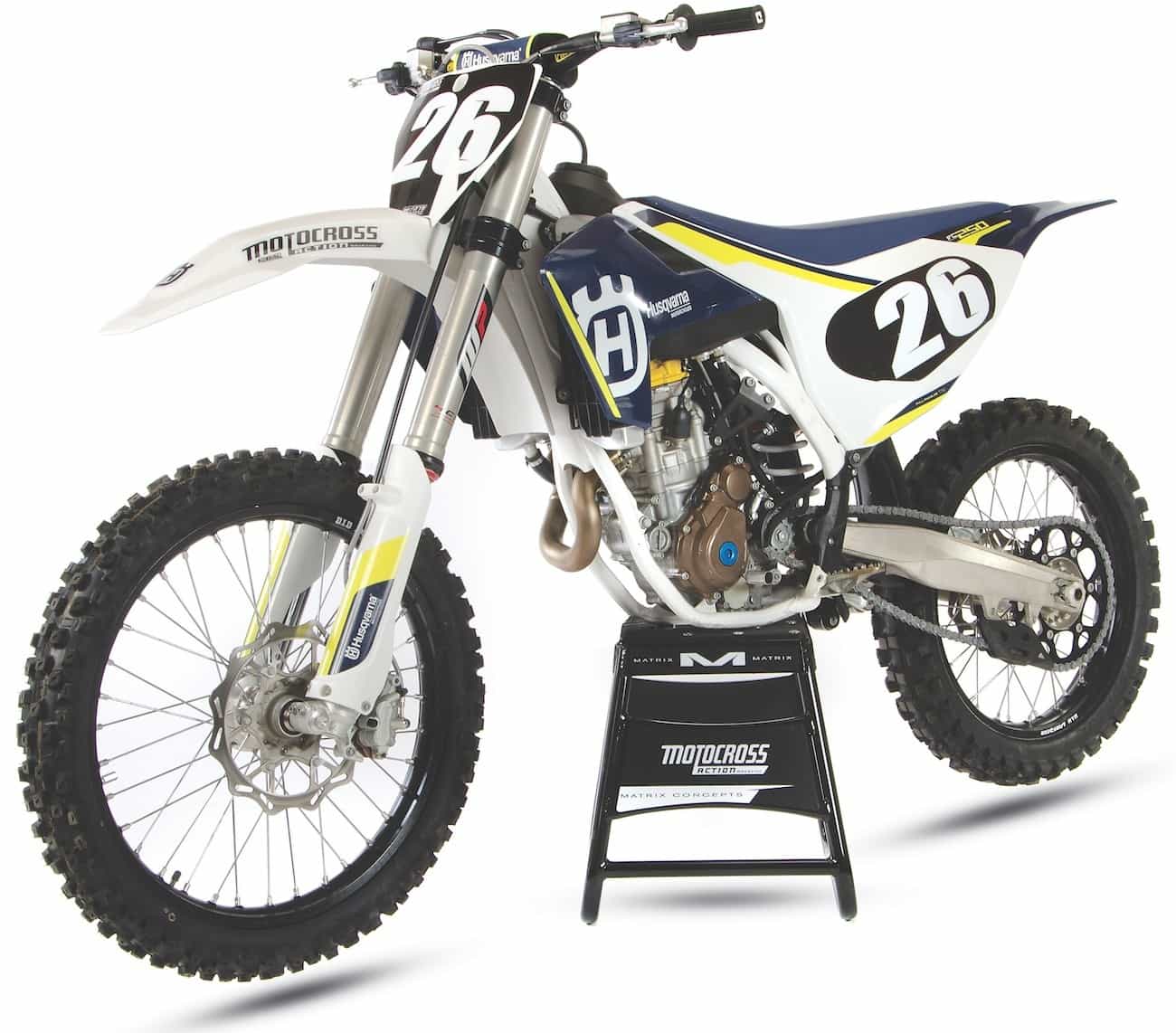 2016 Husqvarna FC250: Thanks to the white/blue/yellow color scheme and creative plastic the 2016 FC250 distances itself from its KTM 250SXF organ donor.
2016 Husqvarna FC250: Thanks to the white/blue/yellow color scheme and creative plastic the 2016 FC250 distances itself from its KTM 250SXF organ donor.
Q: WHAT IS THE HUSQVARNA/KTM CONNECTION?
A: When Husqvarna began to falter under Italian management and BMW ownership in 2013, KTM’s Stefan Pierer stepped in and bought the 112-year-old brand. His motives were both altruistic and economic. Which was which?
Altruism. Pierer didn’t want to see one of the sport’s iconic brands fade away as Bultaco, Maico, BSA, CZ, AJS, Greeves, Hodaka, Puch and Ammex had. Thus, when he moved Husky from Italy to Austria, he saved the grand old marque from being thrown on the ash heap of motorcycle history. It should be noted that in giving Husqvarna a death-row reprieve, he condemned Husaberg to the exact same fate.
Economic. Stefan Pierer believed that KTM could emulate the platform-sharing methods of the automobile industry. For example, Volkswagen uses the same under-pinnings on its VW, Audi, Seat and Skoda brands. The key is to maximize the benefits of economy of scale. Stefan Pierer wants to do that with KTM and Husqvarna.
Q: WHAT ARE THE DIFFERENCES BETWEEN A HUSQVARNA FC250 AND A KTM 250SXF?
A: There is little doubt that platform sharing is the underpinning of Husqvarna’s continued existence; however, differentiating Husqvarna product from KTM product is critical. Back in 2014 KTM just slapped white plastic on a KTM and called it a Husqvarna. That was then, but now the consumer demands more than just a wig, beard and change of clothing from Husqvarna. Here are 10 areas where the Husky isn’t a KTM.
(1) Aesthetics. The Husqvarna’s overall look—from its truncated rear fender to platypus-bill front fender to its ode-to-Sweden color scheme—is unique. From a creative standpoint, the look of the 2016 FC250 is daring.
(2) Clutch. Unlike the KTM, which uses a Brembo clutch lever, master cylinder and slave unit, the Husqvarna uses Magura components.
(3) Carbon fiber subframe. Husqvarna’s claim that its 2016 molded subframe is made with carbon fiber is a little misleading. The subframe is plastic, but carbon particles have been mixed into the plastic formula. It is technically 70-percent plastic and 30-percent carbon.
(4) Swingarm. Husqvarna’s swingarm has considerably different dimensions from the KTM swingarm.
(5) Tires/rims/brakes. Husqvarna specs Dunlop MX52 tires. KTM specs the more race-specific Dunlop MX32 intermediate tires. For racing on prepped tracks, the MX52 can’t touch the MX32 front tire.
(6) Wheels. Husqvarna uses black-anodized D.I.D. DirtStar rims, GFK brake rotors and silver spokes. KTM uses black-anodized Takasago Excel rims, Galfer rotors and powdercoated black spokes.
(7) Weight. The Husky FC250 weighs 2 pounds more than the comparable KTM 250SXF. The extra baggage (223 pounds versus 221 pounds) is a function of the heavier subframe and swingarm.
(8) Handlebars. The 2016 Husky FC250 is outfitted with Pro Taper bars in a proprietary Husqvarna bend. KTM uses Neken bars.
(9) Seat cover. For 2016 Husqvarna switched to a nub-style gripper seat cover that is more aggressive than KTM’s rough-surface cover.
(10) Price. The Husqvarna retails for $100 more than the KTM ($8499 versus $8399).
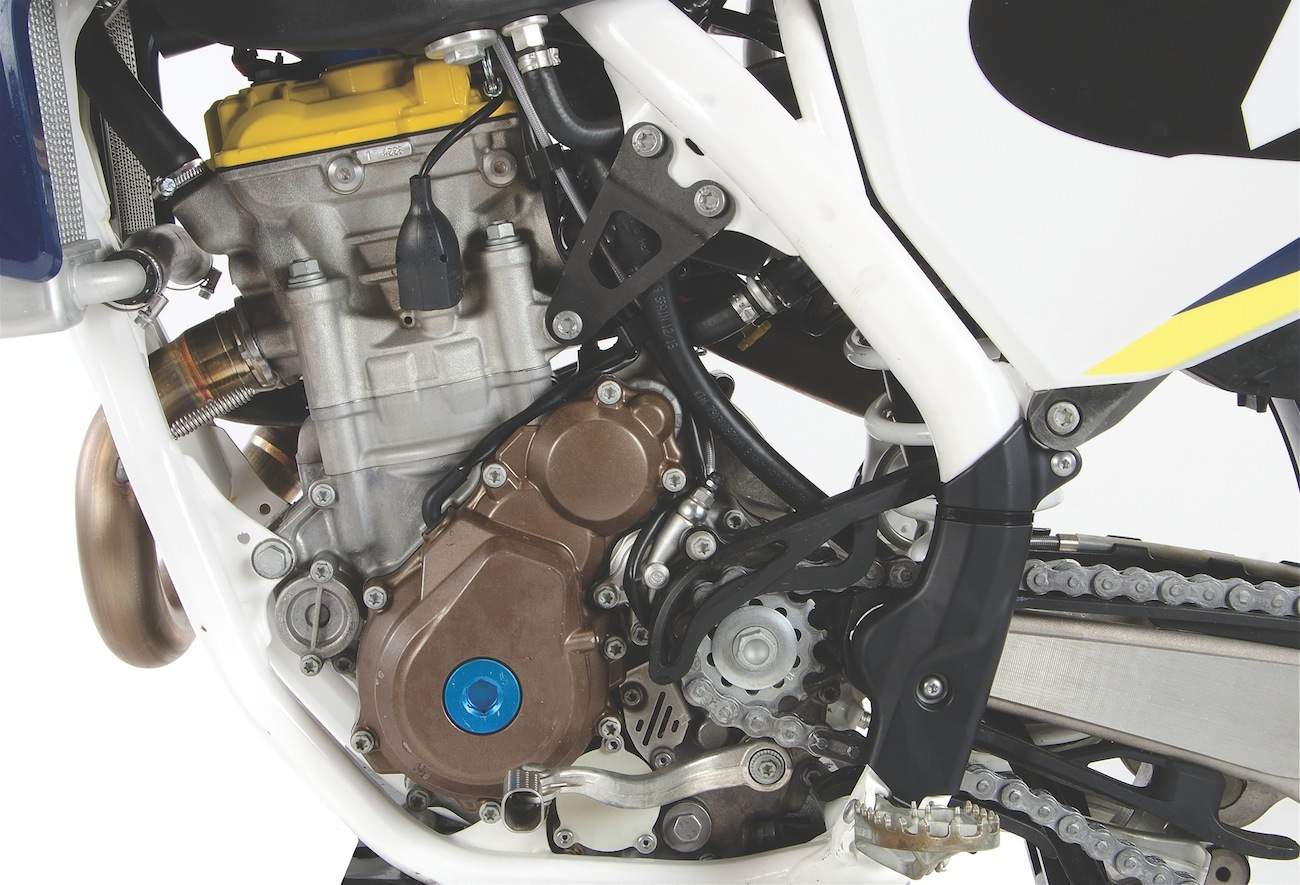 History: What you are looking at here is the first-ever 44-horsepower production 250 four-stroke. Kudos.
History: What you are looking at here is the first-ever 44-horsepower production 250 four-stroke. Kudos.
Q: HOW DOES THE 2016 HUSKY FC250 RUN ON THE DYNO?
A: In what we find to be a strange twist, the 2016 Husqvarna is the most powerful production 250 four-stroke ever. The twist is that this title was held by the 2016 KTM 250SXF for the two months before the Husqvarnas hit American shores. The KTM pumps out 43.76 horsepower at peak. The Husqvarna FC250 eclipses its brother with a stunning 44.38 horsepower at peak. Why do we find it strange? There isn’t a gnat’s breadth of difference between the two engines mechanically. But, this isn’t the first time that Husky has outgunned KTM. In 2015 the Husky FC250 was 1.1 horsepower stronger than the KTM 250SXF.
Why does the Husky FC250 make more power than the KTM 250SXF? In our opinion, it comes down to the airbox (since they have the same exahust pipe, muffler and ECU mapping). Husqvarna’s plastic airbox is totally different from KTM’s. Our biggest complaint about it is that airflow is severely restricted by the molded design, but that restriction has both pluses and minuses. The minuses are that the closed-off airbox hampers throttle response and slows down the revs. This makes the Husqvarna powerband pull a little longer with a steadier metronome-style power pulse. In the saddle you can feel the difference between the two—and most test riders prefer the KTM’s snappier and quicker rev. However, on the plus side, the timed release of the Husqvarna power allows the numbers to build incrementally to a slightly higher-end number; it just takes longer for all the air to get into the engine. It is also possible that the aerodynamics and flow characteristics of the molded airbox lend themselves to processing a more laminar style of airflow.
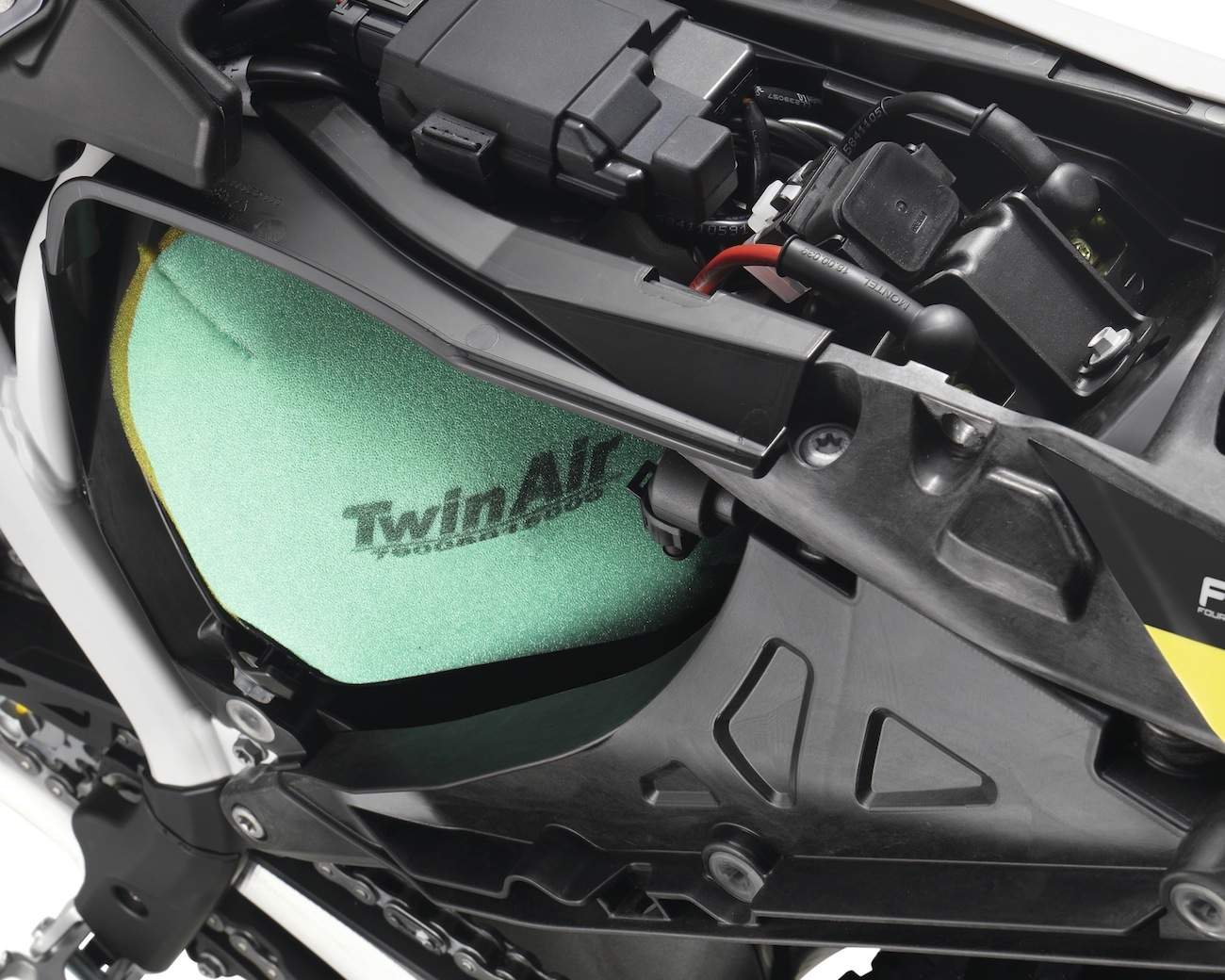 The molded subframe and quick release air filter.
The molded subframe and quick release air filter.
Q: WHAT ELSE IS IMPORTANT ABOUT THE AIRBOX?
A: The MXA wrecking crew members are not fans of Husqvarna’s airbox design—horsepower numbers or not.
It is sealed up tighter than King Tut’s crypt. Husky’s engineers focused little effort on getting adequate air into the airbox; instead, they focused on keeping water out. All well and good for an enduro bike, but this is a motocross bike. As a test, we jerry-rigged a bracket to hold the rear of the airbox cover 1 inch away from the airbox. Test riders did repetitive tests with the stock airbox and propped-open one. No surprise—the FC250 ran better, revved quicker and felt stronger on top with the airbox opened up.
Next, we returned to the dyno room and ran back-to-back tests with the airbox cover in the stock position and with the cover propped open. The opened-up airbox made a 1/2 horsepower more at every point on the powerband. Peak horsepower jumped from 44.38 horsepower to 44.67 horsepower. Now we have to figure out how to get more air into the airbox without sucking dirt or wrecking the flow characteristics.
Q: HOW DOES THE 2016 HUSQVARNA FC250 RUN ON THE TRACK?
A: What’s the best advice you could give a neophyte Husqvarna FC250 rider? Don’t shift. There is never a good reason to short-shift to keep the FC250 engine humming. You ride the Husky FC250 and its KTM cousin by holding on for dear life as the rpm climb to 14,000 rpm. If you are tempted to shift at 11,000 rpm, resist the urge. Why? Because at 11,000 rpm the Husky FC250 is making 41 horsepower. That’s a very good number and better than what the Yamaha, Honda, Suzuki or Kawasaki produce. But if you wait until the rev limiter kicks in at 14,000 rpm, you will be riding a 44-horsepower bike. Think of it this way: you could buy 3 extra horses for your Honda CRF250 for about $2000, or you could just not shift the Husky to get 3 horsepower for free. The choice is yours.
It’s important to note that the Husky FC250 is a top-end-only powerband. Oh, don’t get us wrong, it makes acceptable low and midrange power; it’s just not what it does best. This engine wants to frolic in the high-rpm stratosphere reserved for Chuck Yeager, Commander Cody and Marvin Musquin. If you are fast, this is the fastest production bike you will ever race. This is a Pro powerband. It requires Pro speed to get the most out of it. If you are slow, you will only be fast on the Husky FC250 if you don’t shift. You gotta make this baby rev to get to where the wild things are.
Q: WHAT ABOUT THE GEARING?
A: We changed the gearing from a 13/50 combination to a 13/51 for Vets and Novices. The tighter gearing made it easier to get to 14,000 rpm sooner (and you have to get to 14,000 to get max horsepower). Faster test riders could use the stock 13/50, and National-level Pros could make 13/49 work.
Q: WHAT ABOUT HUSQVARNA’S ELECTRONIC AIDS?
A: The Husky has three maps—stock, mellow and aggressive. Two of the three can be accessed via the handlebar-mounted map switch. You choose which two by selecting from a dial inside the airbox. The handlebar-mounted map switch also doubles as the launch control switch.
Map switch. Inside the airbox, tucked in the upper right-hand corner, is a rubber-covered dial. If you turn the dial until the arrow points at setting 1, you get the mellow map when the map switch is in its rearward (two dash) position. If you turn the dial until the arrow points at setting 2, you get the aggressive map when the map switch is in its rearward (two dash) position. If you turn the dial until the arrow points at settings 3, 4, 5, 6, 7, 8, 9 or 0, you get another stock map when the map switch is in its rearward (two dash) position. Note: you always have the stock map in the forward switch position, while the rearward switch position can have a mellow, aggressive or stock map. We always ran the aggressive mode (setting 2).
Launch control. We could write a book on how to get the most from the Husky launch control system, but who would read it? Instead, here are the basics: To engage launch control, flick the handle-mounted map switch forward and backward one time. This will cause the EFI light behind the front number plate to flash. As long as it is flashing, the FC250 is in launch control. Whatever you do, don’t blip the throttle while launch control is engaged or it will disengage (requiring you to turn the bike off and start it again to get launch control back on). Instead, apply steady throttle until the gate drops. Oh yeah, not a single MXA test rider used the launch control mode on the Husqvarna FC250.
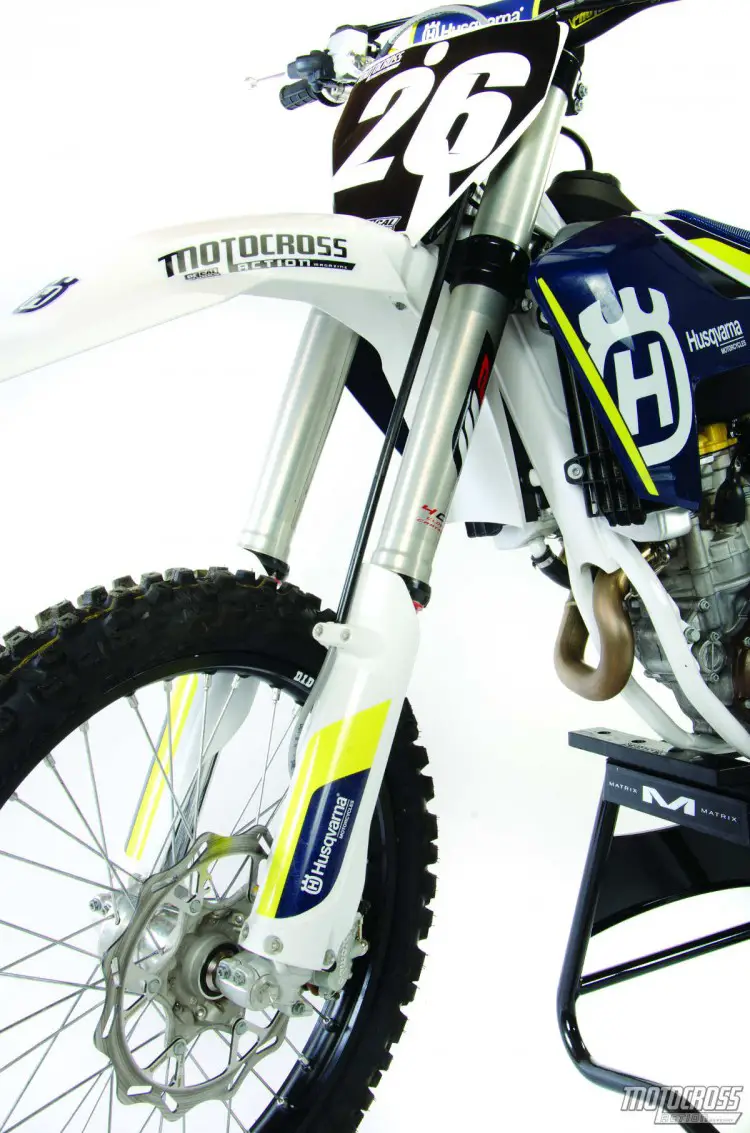
Target: Husky has different valving than KTM, but their target was still Vets, Novices and regular folk.
Q: HOW GOOD ARE THE WP 4CS FORKS?
A: They’re good. Not great. Not without flaws, but raceable—if you are in the chosen demographic. We like this year’s 4CS forks better than last years, but really want the 2017 AER air forks to get here quickly. These forks are not on a par with Yamaha’s SSS forks, but they are better than previous WP offerings. They aren’t the old horrendous WP forks of our nightmares. They are raceable in stock trim and, for the first time in a long time, like forever, test riders could get satisfaction out of the compression clickers. Slow riders could turn them out from the stock 15-click settings and faster riders could turn them in. The 2016 WP 4CS forks emphasize a plusher feel.
One caveat: These forks are designed to work best for Vets and Novices. Pros will most likely bottom them over anything bigger than a Snickers wrapper. We accept this, just as we accept that there are no Pros running stock forks anywhere on the planet. We applaud WP for being brave enough to build fork settings that work for a major portion of their buying public, even if it doesn’t sit well with the elitists. However, the worst aspect of the 2016 Husky FC250 forks is the chatter they induce in consecutive bumps at high speed. In choppy braking bumps they feel confused, hyper-active and schizoid.
Q: HOW DOES THE 2016 HUSKY FC250 HANDLE?
A: It handles just like a KTM—with a bad front tire. Job number one is to exchange the stock Dunlop MX52 for your favorite front tire. If the MX52 is your favorite front tire, carry your medical insurance card on your person at all times. Since the Husky FC250’s geometry, weight bias and balance are identical to that of the sweet-handling KTM 250SXF, this bike should feel like a dream. And it will with a decent front tire.
Q: WHAT DID WE HATE?
A: The hate list:
(1) Exhaust. You can’t take the pipe off the bike without removing the shock. Set aside an hour and a swear jar, then make yourself rich trying to get the pipe off the bike.
(2) Sprocket bolts. Watch the sprocket bolts closely. They loosen up easily.
(3) Shift lever. We broke two shift-lever tip springs on our KTM, and since the shifter is the same on the Husky, we would expect to break it also. However, after the first spate of broekn springs we suffered no more trouble. It might have been a pre-pro problem.
 If your 2016 Husqvarna/KTM rear brake pedal spring is installed with the bottom tang sticking out towards your boot, you need to take it off and turn it around—before it falls off when your boot hits it.
If your 2016 Husqvarna/KTM rear brake pedal spring is installed with the bottom tang sticking out towards your boot, you need to take it off and turn it around—before it falls off when your boot hits it.
(4) Brake pedal spring. Husqvarna puts the brake pedal spring on with the bottom tang aimed outward. In this position, the rider’s boot can nudge it out of the pedal. We turn the spring around so that the tang on the brake pedal aims inward. Then, we crimp the tangs so they can’t fall off.
(5) Rear fender. Who wears short-shorts? It needs about 2 inches more.
(6) Airbox. We know that Husqvarna has heard this complaint before, so why would they build a totally new airbox for 2016 that still doesn’t breathe.
(7) Spacers. There are metal spacers in the seat bolt hole and right side panel that fall out when you remove either of these two bolts. Shouldered bolts or tolerance-fit spacers would have solved this problem.
(8) Front tire. There is a place in the world for the Dunlop MX52 front tire, but in a direct comparison against KTM’s MX32 front tire, it’s no contest.
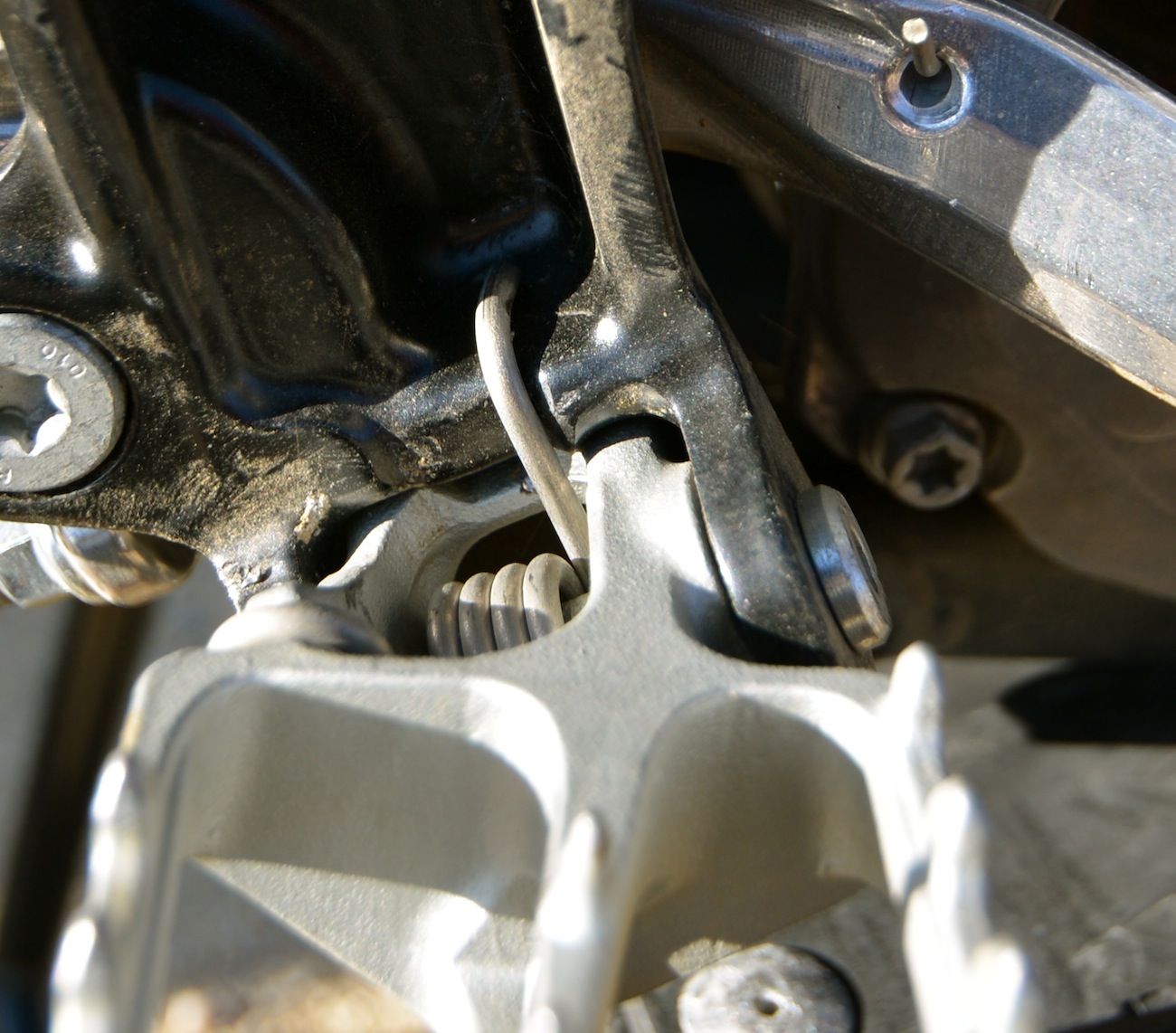 If your 2016 Husqvarna/KTM footpeg spring doesn’t hook above the frame, it was installed improperly at the dealership.
If your 2016 Husqvarna/KTM footpeg spring doesn’t hook above the frame, it was installed improperly at the dealership.
(9) Footpeg springs. MXA has never broken a KTM or Husky footpeg spring, but we have taken the time to lift the plastic frame guard to check and see that the dealership put the footpeg springs on correctly. Amazingly, many dealers do it wrong—and when they do the spring breaks.
(10) Frame guard. Husky puts black frame guards on the white tubes to protect them from boot rub. But, because the frame guards are black Husqvarna didn’t want them to go up so high as to hurt the aesthetics of the white frame paint. The end result of Husky’s form-over-function decision is that your boots will wear the white paint off directly above the point where the plastic guards end.
Q: WHAT DID WE LIKE?
A: The like list:
(1) Handling. We love this chassis. With the right front tire you could put the FC250 wherever you wanted it. It steered with minimal handlebar input and was incredibly neutral.
(2) Weight. Even though the Husqvarna FC250 weighs 2 pounds more than the KTM 250SXF, it is still 2 pounds lighter than the RM-Z250, KX250F and CRF250. And that is with an electric starter and a battery.
(3) Air filter. The Twin Air filter in the Husqvarna FC250 is light years ahead of the other brands’ cramped, bank vault-style designs. It is so easy to remove that you are almost tempted to do it regularly.
(4) Maps. The 2016 Husqvarna FC250 comes with three different maps. Every MXA test rider ran the aggressive map, but there is no actual horsepower difference between the stock map and the aggressive map. It’s more a matter of throttle response than ponies.
(5) Clutch. The self-adjusting hydraulic clutch is the best on the market. It feels different from a cable clutch but is easy to adapt to. We like the smoother modulation of the Magura master cylinder compared to the KTM’s Brembo unit.
(6) Brakes. Hands down the best brakes in the class (other than the KTM 250SXF’s brakes, of course).
(7) Shifting. The transmission shifts with ease under a load. It is very impressive when rated against the competition; however, it doesn’t like to go into neutral when the engine is running.
(8) Electric start. Once you own an electric-start motocross bike, you’ll wonder why they don’t put this on cars, boats, airplanes and golf carts.
(9) Aesthetics. The bike looks great with its yellow, blue and white color scheme. Plus, the left-side panel can be removed without any tools. We wish the right-side panel didn’t have its one odd-sized Torx bolt, because it ruins what was a great idea.
(10) Muffler. Unlike the 2016 Husky FC450, which had an ice-cream-cone-shaped restrictor in the muffler’s perf core, the Husky FC250 doesn’t have any restrictors (save for a wire screen that lasts less than one hour before it blows out). We aren’t complaining, because it saved us the trouble of taking it out.
Q: WHAT DO WE REALLY THINK?
A: Amazingly, even the MXA test riders, who were well aware of the remarkable similarities between the Husqvarna and KTM, were drawn to the differences. We want Husqvarna to chart its own course in the future, but as for now we aren’t turning our noses up at a 44-horsepower 250 four-stroke.
MXA’S HUSQVARNA FC250 SETUP SPECS
This is how we set up our 2016 Husqvarna FC250 for racing. We offer it as a guide to help you find your own sweet spot.
4CS FORK SETTINGS
“Plush” is the best word to describe the WP 4CS forks, but plush doesn’t cover all the possible sins that a fork is designed to protect against. Theses forks are geared towards light riders who don’t put too much energy into the front end. We cranked in on the clickers until they stopped bottoming and used the rebound to slow down the ramping-up effect. For hard-core racing, we recommend this fork setup on the 2016 Husqvarna FC250 (stock specs are in parentheses):
Spring rate…4.6 N/m
Compression…12 clicks out (15 clicks out)
Rebound… 10 clicks out (15 clicks out)
Fork leg height…5mm up
Notes: We love that WP uses no-tools adjusters to make clicker changes a breeze. There’s no need to drop the oil height this year; in fact, we stiffened up the compression in order to keep the forks from bottoming under fast riders. Fast riders might even have to add 10cc of oil. Slower and older riders turned the compression out all the way (and some might take out 10cc).
WP SHOCK SETTINGS
It’s nice that Husqvarna embossed a sag-scale line on the rear fender to ensure that riders are measuring their race sag in the proper location. For hard-core racing, we recommend this shock setup for the 2016 Husqvarna FC250 (stock specs are in parentheses):
Spring rate: 45 N/m
Race sag: 105mm
Hi-compression: 1-3/4 turns out (2 turns out)
Lo-compression: 15 clicks out
Rebound: 10 clicks out (15 clicks out)
Notes: We turned the high-speed compression damping in to help hold the shock higher in its stroke, especially under a load. Depending on rider preference, we ran around 105mm of race sag to balance out the chassis.



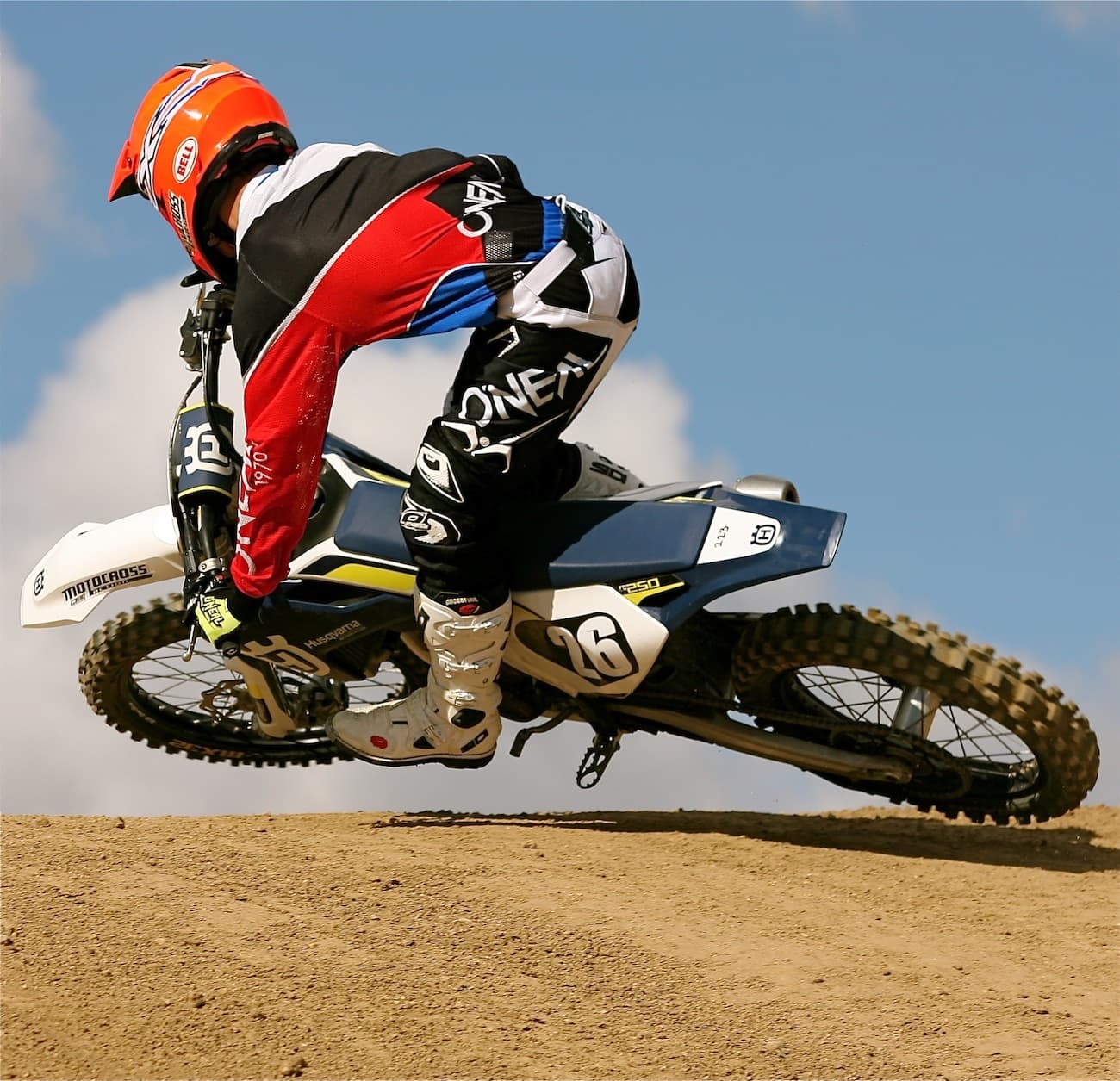
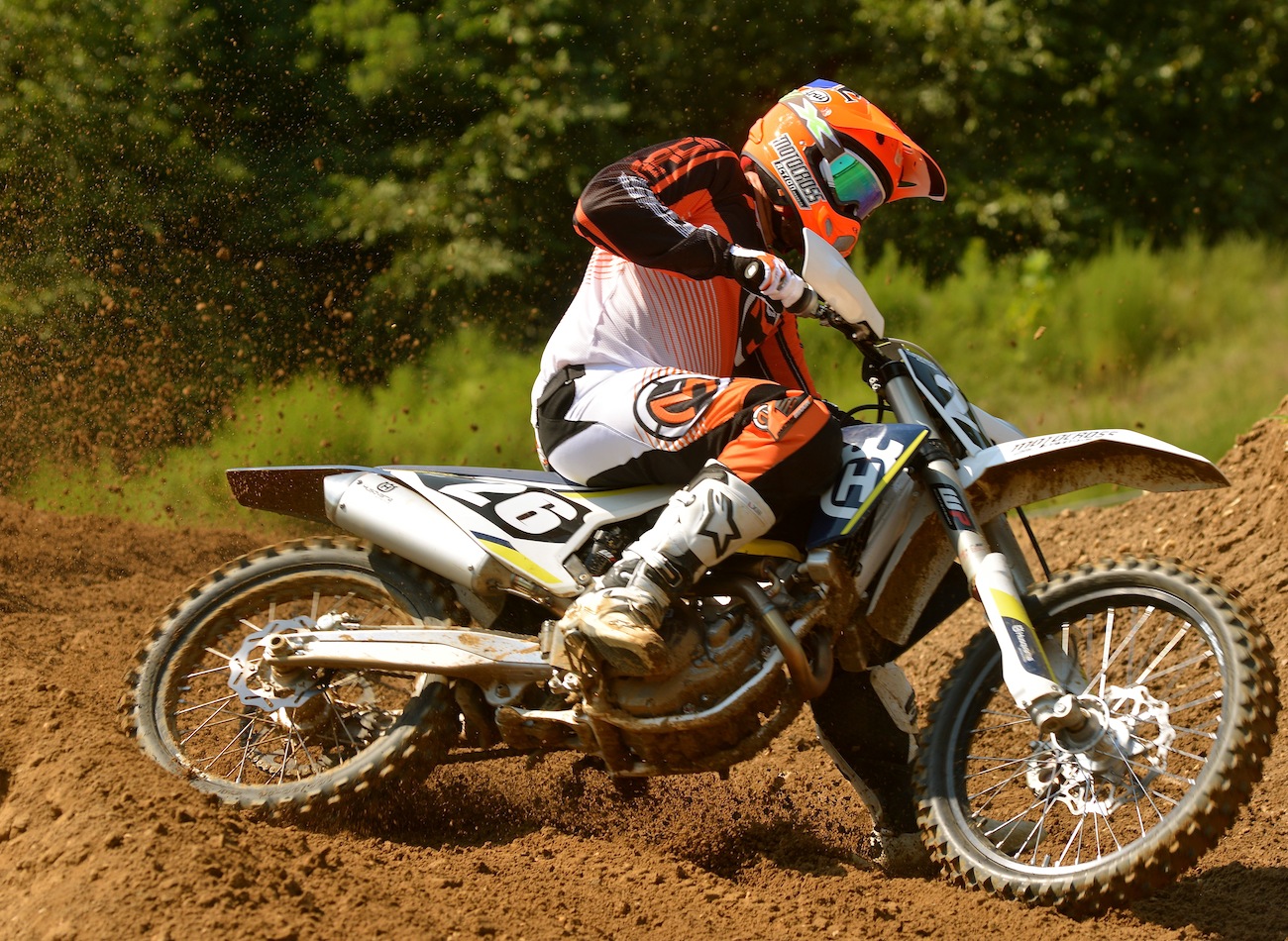
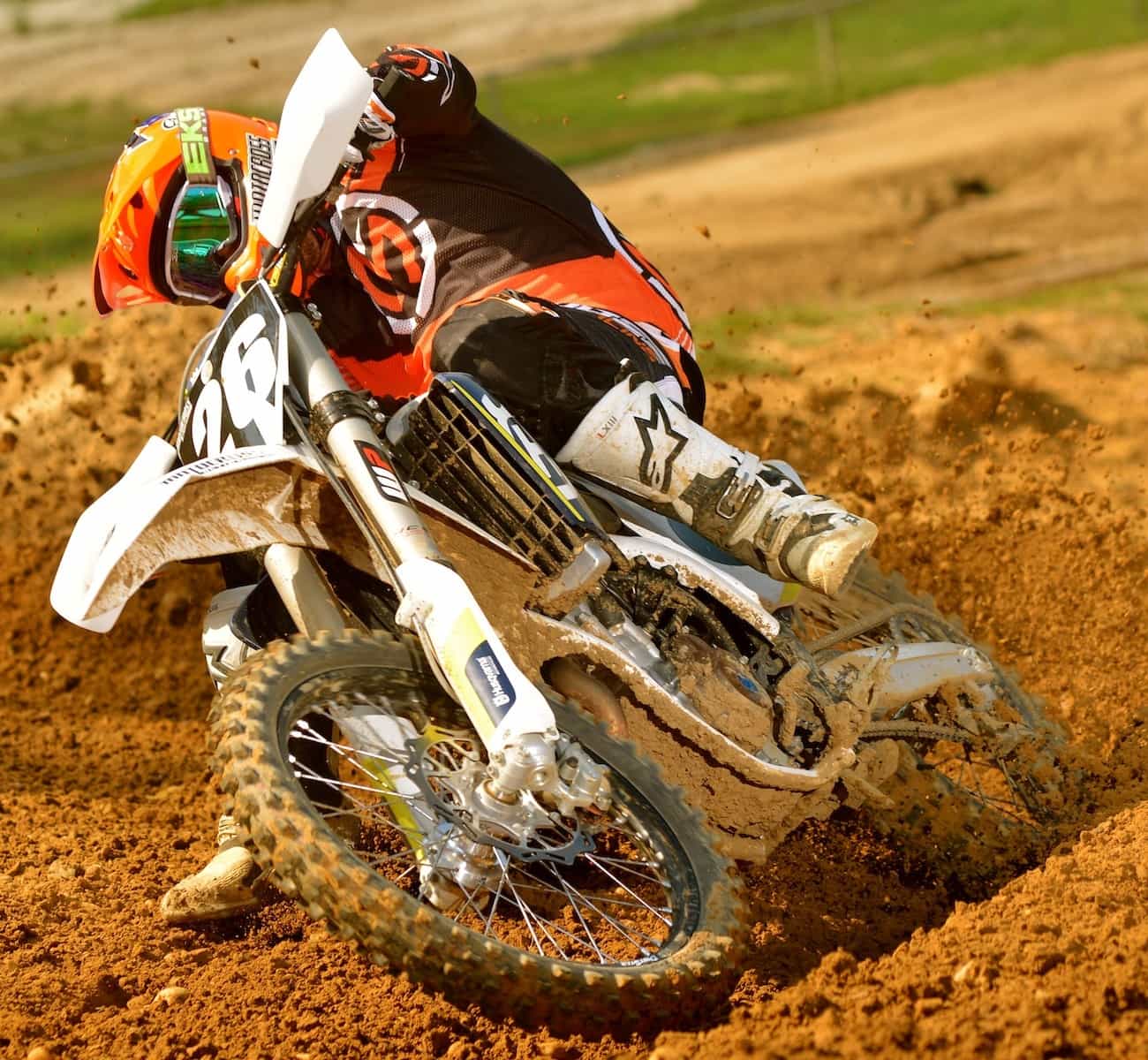


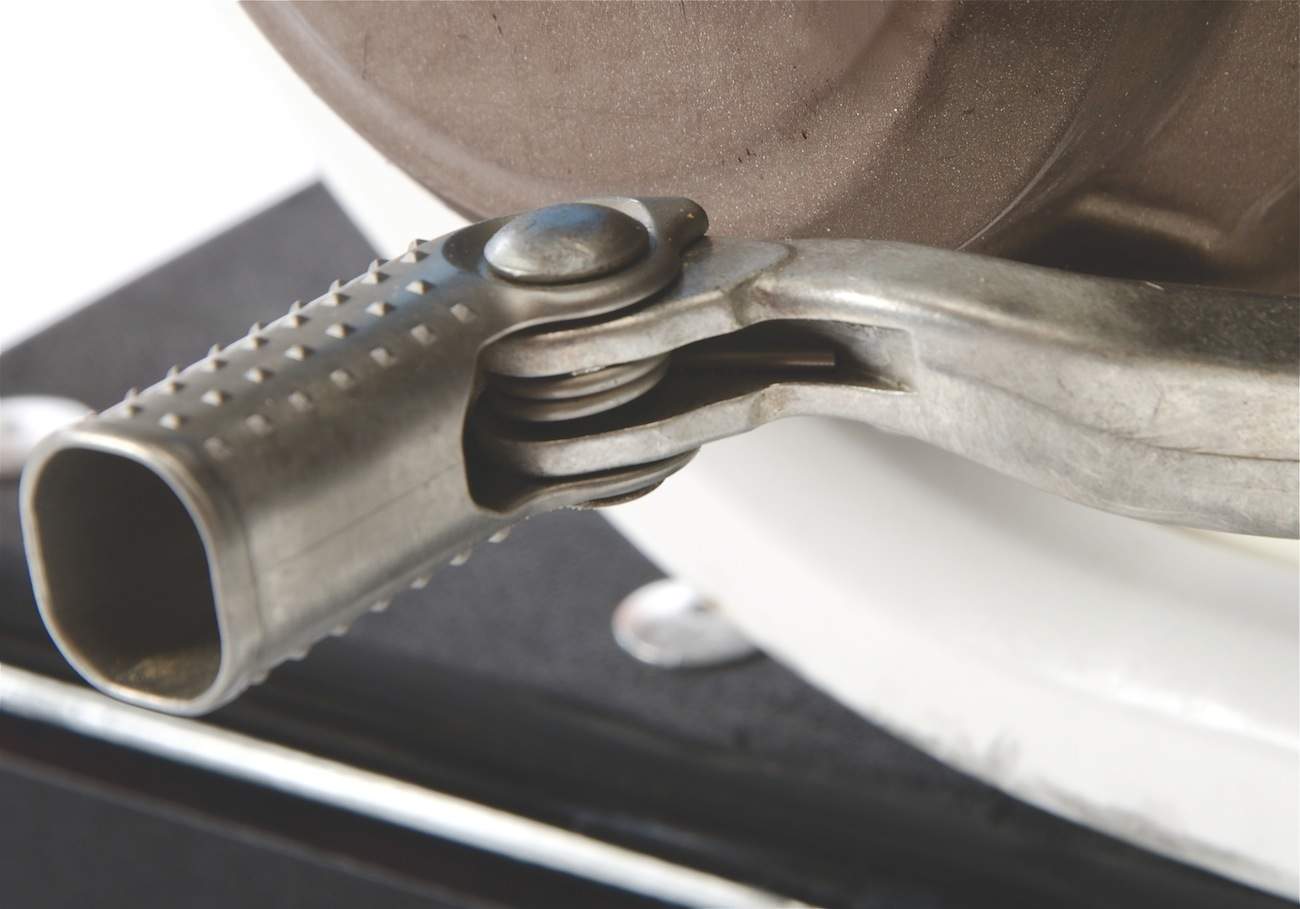


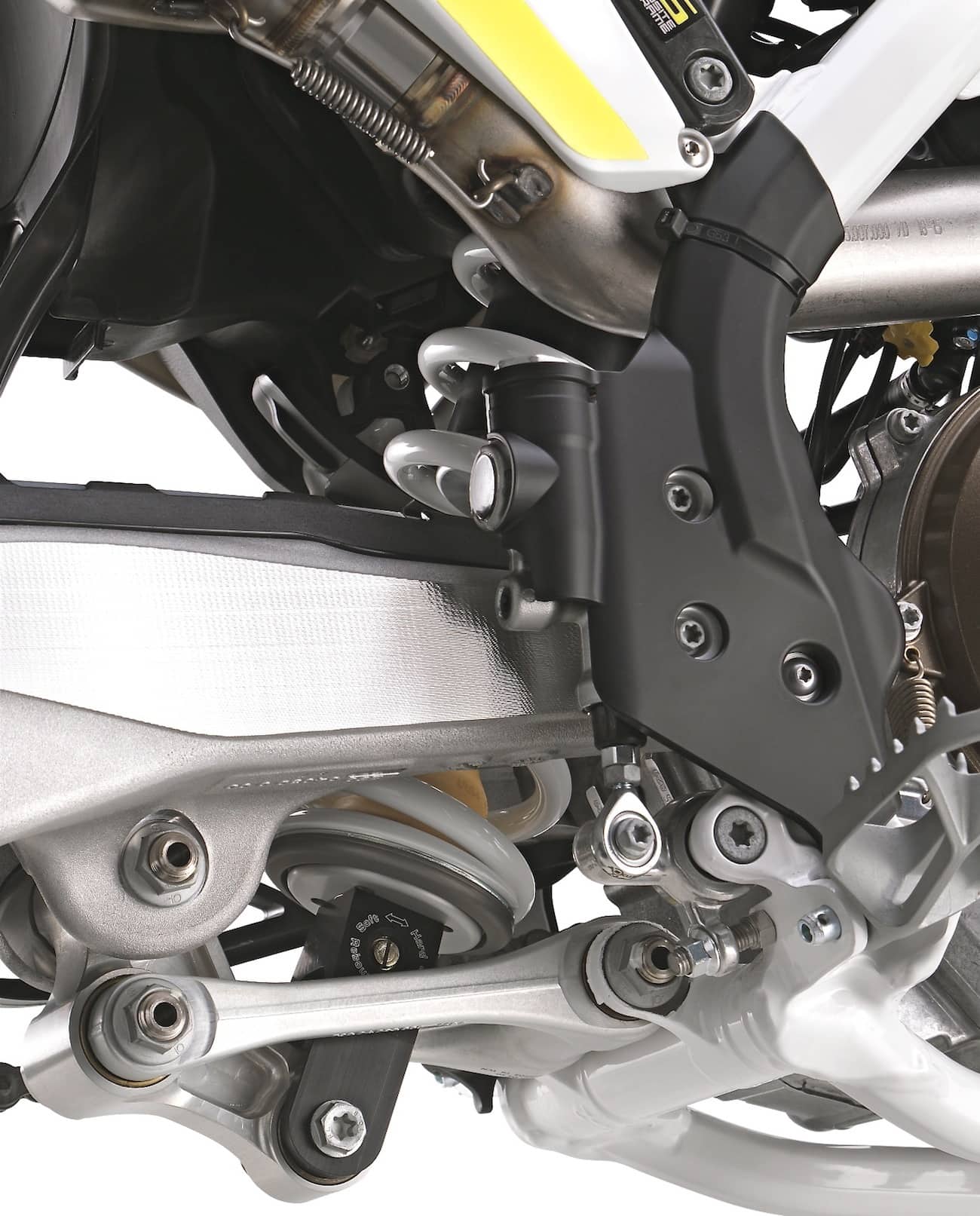
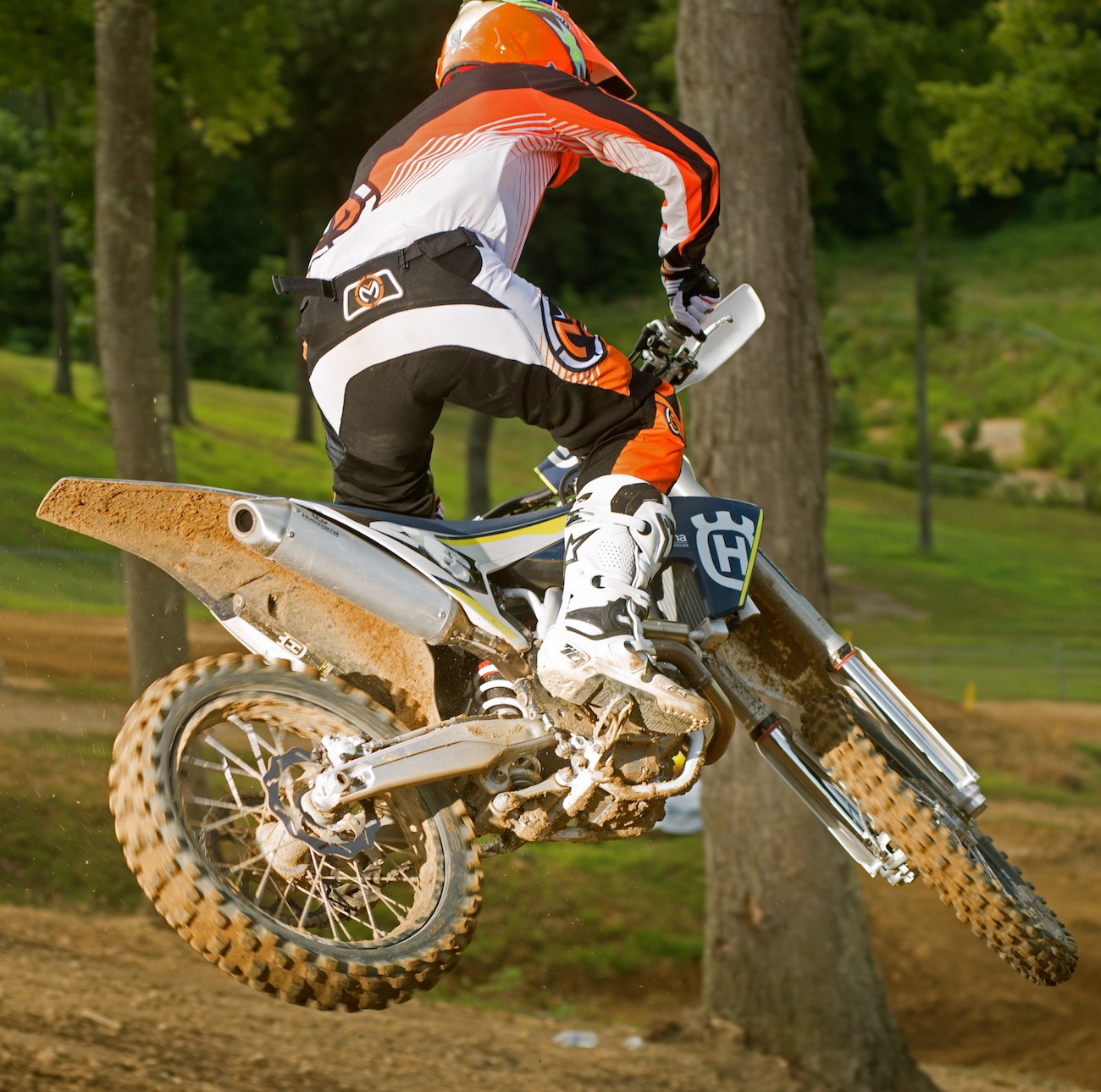


Comments are closed.